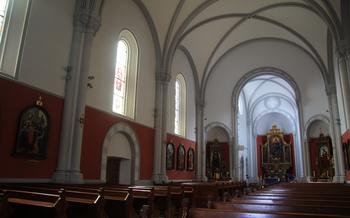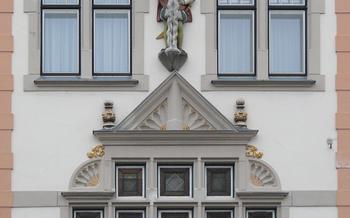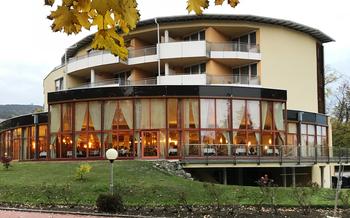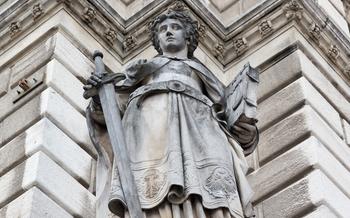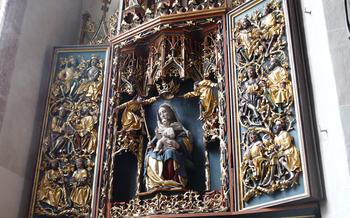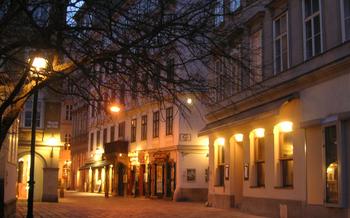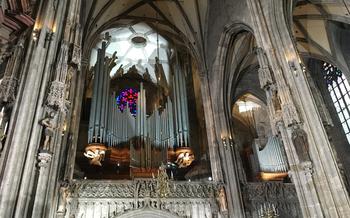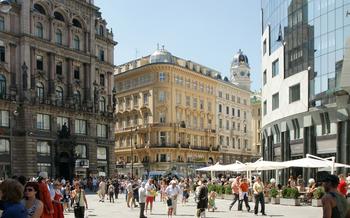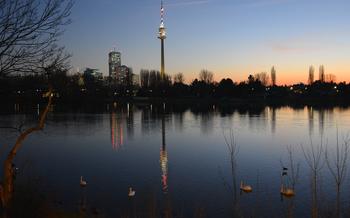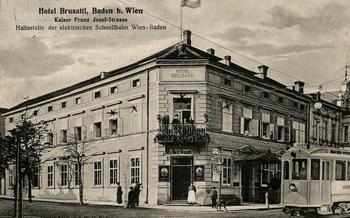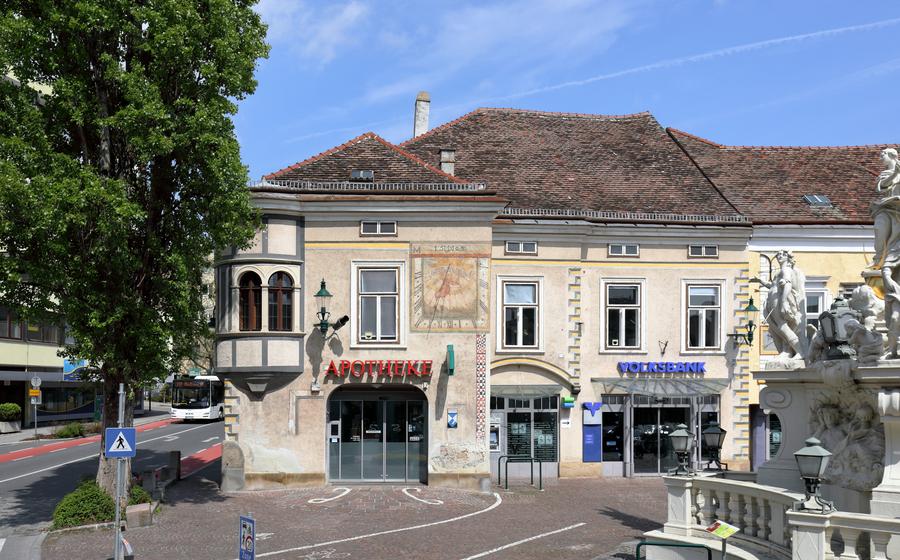
Danube Tower (Donauturm)
- History of the Danube Tower (Donauturm)
- Architecture and Design of the Danube Tower
- Views from the Danube Tower
- Restaurant and Cafe at the Danube Tower
- Events and Activities at the Danube Tower
- Getting to the Danube Tower
- Accessibility for Visitors with Disabilities
- Tips for Visiting the Danube Tower
- History of the Danube River
- The Danube River in Vienna
- The Danube Island (Donauinsel)
- The Old Danube (Alte Donau)
- The New Danube
History of the Danube Tower (Donauturm)
The Danube Tower (Donauturm) is a 252-meter tall observation tower located in Vienna, Austria. It was built between 1962 and 1964 and was designed by Hannes Lintl, an Austrian architect. The tower was originally conceived as a symbol of Austrian reconstruction and progress following World War II. It was also intended to serve as a communications tower for radio and television broadcasting. Over the years, the Danube Tower has become a popular tourist attraction, offering stunning views of Vienna and the surrounding countryside. It has also been used for various events and activities, such as concerts, exhibitions, and even weddings.
Architecture and Design of the Danube Tower
The Danube Tower stands at a height of 252 meters (827 feet), making it one of the tallest structures in Austria. It was constructed using reinforced concrete and steel, and its slender, cylindrical shape is reminiscent of a rocket or a space needle. The tower's exterior is painted in a striking white color, which gives it a futuristic appearance.
One of the most unique features of the Danube Tower is its rotating restaurant, which offers panoramic views of Vienna and the surrounding countryside. The restaurant completes a full rotation every 26 minutes, allowing diners to enjoy a constantly changing perspective of the city. The tower also features a cafe, a bar, and several observation decks, which offer visitors breathtaking views of the city and the surrounding area.
Views from the Danube Tower
A breathtaking panorama awaits visitors to the Danube Tower, offering unparalleled vistas of Vienna and its surroundings. From the observation deck, which stands at a height of 155 meters, you can enjoy 360-degree views that stretch for miles in every direction. On a clear day, the visibility can extend up to 80 kilometers, allowing you to see as far as the Schneeberg in Lower Austria and the Leitha Mountains in Burgenland.
The Danube Tower's unique position on the banks of the Danube River provides visitors with stunning views of the river itself, as well as the city's many landmarks and attractions. To the north, you can see the historic city center, with its iconic spires and domes, including St. Stephen's Cathedral, the Hofburg Palace, and the Rathaus. To the south, you can admire the vast expanse of the Vienna Woods, with its lush forests and rolling hills.
The Danube Tower is also a popular spot for watching sunsets and sunrises. As the sun dips below the horizon, the sky transforms into a vibrant canvas of colors, casting a warm glow over the city. Similarly, the sunrise offers a magical spectacle, as the first rays of sunlight illuminate the awakening city.
Restaurant and Cafe at the Danube Tower
The Danube Tower boasts two dining options: the Danube Tower Restaurant and the Danube Tower Cafe. The restaurant offers a refined dining experience with panoramic views of the city. The menu features a variety of Austrian and international dishes, prepared with fresh, seasonal ingredients. The cafe, on the other hand, offers a more casual dining experience with a selection of light meals, snacks, and beverages. Both the restaurant and the cafe offer stunning views of the city, making them ideal places to enjoy a meal or a drink while taking in the sights of Vienna.
The Danube Tower Restaurant is open for lunch and dinner, with a set menu for lunch and an à la carte menu for dinner.
Events and Activities at the Danube Tower
The Danube Tower is not just a viewing platform; it also hosts various events and activities throughout the year. These events and activities are a great way to experience the tower in a different way and to enjoy the stunning views of Vienna.
Some of the most popular events and activities at the Danube Tower include:
- Concerts: The Danube Tower hosts regular concerts featuring a variety of musical genres, from classical to jazz to pop.
- Exhibitions: The Danube Tower also hosts a variety of exhibitions, including art exhibitions, photography exhibitions, and historical exhibitions.
- Weddings: The Danube Tower is a popular venue for weddings, offering couples a unique and unforgettable setting for their special day.
- Conferences and events: The Danube Tower can also be rented for conferences and events, providing a unique and memorable setting for your business or social event.
The Danube Tower also offers a variety of activities for children, including a playground, a climbing wall, and a virtual reality experience.
To find out more about the events and activities at the Danube Tower, visit the tower's website or contact the tower's staff.
Getting to the Danube Tower
Location, Public Transportation, Parking
The Danube Tower is situated in Donaupark, a vast recreational area in Vienna’s 22nd district, Donaustadt. It is easily accessible using various modes of transportation.
For those opting for public transport, take the U1 underground line and alight at the Donaumarina station. From there, follow the signs for a 10-minute walk to the Danube Tower.
If you prefer driving, take the A23 highway and exit at Donaustadt. Follow the signs for Donaupark, and you'll find the Danube Tower within the park grounds. Ample parking is available on-site, ensuring a hassle-free visit.
Accessibility for Visitors with Disabilities
The Danube Tower is wheelchair accessible. There is a special elevator that takes visitors with disabilities to the observation deck. There are also accessible restrooms on the observation deck. Visitors with disabilities can get assistance from the staff at the Danube Tower. For example, the staff can help visitors with disabilities get on and off the elevator and can provide them with information about the Tower. There are no discounts available for visitors with disabilities.
Tips for Visiting the Danube Tower
-
Best time of day to visit: Aim for sunrise or sunset to capture the city's most magical hues. For clear views, avoid visiting on foggy or rainy days.
-
Duration of visit: Plan to spend at least an hour at the Danube Tower, allowing ample time to soak in the views, visit the restaurant or cafe, and explore the exhibitions.
-
What to wear and bring: Dress comfortably for the weather, as the tower can be chilly, especially at higher altitudes. Bring along a camera to capture the stunning vistas and binoculars to enhance your sightseeing experience.
-
Special events and activities: Keep an eye out for special events and activities held at the Danube Tower, such as concerts, exhibitions, and themed nights. These events offer a unique opportunity to enjoy the tower in a different light.
History of the Danube River
The Danube River, a crucial waterway that courses through the heart of Europe, boasts a rich and captivating history. Its formation dates back to the Miocene epoch, roughly 11 million years ago, when tectonic shifts and the movement of the Earth's crust birthed this mighty river. Over the millennia, the Danube has carved its path through diverse landscapes, creating a natural corridor that has profoundly shaped human civilization.
From its humble beginnings in the Black Forest of Germany, the Danube River embarks on a meandering journey of over 1,770 miles (2,850 kilometers) before emptying into the Black Sea. Along its course, it traverses ten countries, each contributing to the river's unique character and cultural significance. These nations include Germany, Austria, Slovakia, Hungary, Croatia, Serbia, Romania, Bulgaria, Moldova, and Ukraine.
The Danube River has long been a vital artery for trade, commerce, and cultural exchange among the nations it touches. Its waters have borne witness to the rise and fall of empires, the migration of peoples, and the unfolding of countless historical dramas. From the Roman Empire to the Austro-Hungarian Empire, the Danube has played a pivotal role in shaping the political, economic, and cultural landscape of Central and Southeastern Europe.
The Danube River in Vienna
The Danube River, a majestic waterway that courses through the heart of Europe, lends its charm to the vibrant city of Vienna. Spanning a length of approximately 35 kilometers within the Austrian capital, the river becomes an integral part of the city's landscape, offering a plethora of opportunities for exploration and recreation.
Vienna's Danube Riverfront boasts an array of iconic landmarks that draw visitors from far and wide. The majestic Schönbrunn Palace, a sprawling complex that once served as the imperial summer residence, stands as a testament to the city's rich history. With its meticulously landscaped gardens, opulent interiors, and world-renowned Gloriette, Schönbrunn Palace is a must-visit destination for any traveler.
Another architectural gem that graces the Danube's edge is the Karlskirche, a stunning Baroque church known for its distinctive oval dome. Its intricate facade, adorned with intricate carvings and sculptures, is a testament to the artistry and craftsmanship of the era. The Karlskirche's interior is equally impressive, featuring soaring columns, elaborate frescoes, and a magnificent high altar.
For those seeking a more active experience, the Danube River offers a variety of water-based activities. From leisurely boat tours that provide panoramic views of the city's skyline to adrenaline-pumping jet boat rides, there is something for every taste and preference. Visitors can also embark on a leisurely bike ride or a refreshing stroll along the Danube Riverbank, taking in the sights and sounds of this vibrant waterway.
The Danube River is not just a natural wonder but also a vital part of Vienna's cultural heritage. Throughout history, the river has played a crucial role in shaping the city's economy, trade, and cultural exchange. Today, it continues to be a source of inspiration for artists, writers, and musicians, who find endless beauty and tranquility in its ever-flowing waters.
The Danube Island (Donauinsel)
Nestled between the Old Danube and the New Danube, the Danube Island (Donauinsel) is a narrow strip of land stretching for 21 kilometers. Created in the 1970s as part of a flood control project, the island has transformed into a vibrant recreational oasis in the heart of Vienna.
With its vast green spaces, the Danube Island is a popular destination for locals and tourists alike. Whether you're seeking relaxation or adventure, the island offers a plethora of activities to suit every preference.
For those seeking tranquility, the island's serene beaches provide a perfect escape from the urban hustle. Take a leisurely stroll along the Danube River, bask in the warm sunshine, or simply unwind with a picnic on the grassy shores.
Adventure enthusiasts can indulge in an array of thrilling water sports. The Danube Island is a haven for swimming, sailing, windsurfing, and kayaking enthusiasts. Rent a boat or join a guided tour to explore the river's hidden gems.
Families with children will find ample entertainment on the island. There are several playgrounds, as well as a water park with slides, pools, and splash zones. The Danube Island also hosts regular events and festivals throughout the year, offering a variety of entertainment options for all ages.
Getting to the Danube Island is a breeze. Hop on the U1 subway line and alight at the Donauinsel station. Alternatively, you can take the S1 or S7 suburban train to the Handelskai station and walk across the bridge to the island.
With its endless recreational possibilities and stunning natural beauty, the Danube Island is a must-visit destination for anyone seeking a rejuvenating escape in the heart of Vienna.
The Old Danube (Alte Donau)
The Old Danube, a serene and picturesque body of water, is a former section of the Danube River that was separated from the main channel during flood control works in the late 19th century. This tranquil haven, located in the northeast of Vienna, offers a tranquil escape from the bustling city center and invites visitors to immerse themselves in its natural beauty and recreational opportunities.
Formed in 1875, the Old Danube stretches for approximately 12 kilometers, meandering through a landscape adorned with lush greenery, charming parks, and idyllic beaches. Its calm waters provide a perfect setting for a variety of water sports and activities, including swimming, sailing, kayaking, and paddleboarding. Anglers will also find solace in its tranquil depths, where they can cast their lines in pursuit of carp, pike, and other freshwater fish.
In addition to its aquatic allure, the Old Danube is also a haven for wildlife. Its reed beds and marshy areas provide a sanctuary for numerous bird species, including herons, ducks, and geese, making it a popular destination for birdwatching enthusiasts. The surrounding parks and forests offer ample opportunities for leisurely strolls, cycling, and exploration, allowing visitors to connect with nature and escape the urban hustle and bustle.
Whether you seek relaxation, adventure, or simply a tranquil retreat, the Old Danube offers a diverse range of experiences for visitors of all ages. Its serene waters, picturesque landscapes, and abundance of recreational activities make it a beloved destination for locals and tourists alike, offering a glimpse into the natural side of Vienna.
The New Danube
The New Danube (Neue Donau) is a 21-kilometer-long artificial channel of the Danube River in Vienna, Austria. It was built between 1972 and 1988 as part of a flood control project to reduce the risk of flooding in the city. The New Danube is a popular spot for swimming, sunbathing, fishing, and other water sports. It is also a popular place for people to go for walks, runs, or bike rides.
The New Danube is lined with several parks and beaches, including the Donauinsel (Danube Island), which is a popular spot for swimming, sunbathing, and playing beach volleyball. The New Danube is also home to several rowing and sailing clubs.
There are several ways to get to the New Danube. You can take the U1 subway line to the Donauinsel station, or you can take the S7 S-Bahn line to the Handelskai station. You can also get to the New Danube by car, but there is limited parking available.
The New Danube is a great place to visit for a relaxing day outdoors. You can swim, sunbathe, fish, or go for a walk, run, or bike ride. There are also several restaurants and cafes along the New Danube where you can get a bite to eat or a drink.
